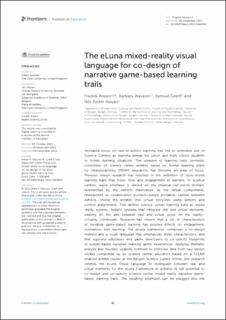| dc.description.abstract | Increased focus on out-of-school learning has led to extended use of Science Centers as learning arenas for junior and high school students in formal learning situations. The creation of learning trails, semantic collections of science center exhibits based on formal learning plans for interdisciplinary STEAM education, has become an area of focus. Previous design research has resulted in the definition of story-driven learning trails that foster flow and engagement in learners. In science centers, equal emphasis is placed on the physical real-world domain, represented by the exhibits themselves, as the virtual components, represented as collaborative positions-based portables carried between exhibits, linking the exhibits into virtual storylines using sensors and control assignments. This defines science center learning trails as mixed reality systems; holistic systems that integrate real and virtual elements, existing on the axis between real and virtual poles on the reality–virtuality continuum. Research has shown that a set of characteristics of narrative game-based learning has positive effects on engagement, motivation, and learning. The eLuna Framework comprises a co-design method and a visual language that emphasizes these characteristics, and that supports educators and game developers to co-specify blueprints of screen-based narrative learning game experiences. Applying thematic analysis and heuristic usability methods to interview data from two design studies completed by six science center educators based on a STEAM enabled exhibit cluster at the Bergen Science Centre VilVite, this research extends the eLuna Visual Language to distinguish between real and virtual elements for the eLuna Framework to achieve its full potential to co-design and co-specify science center mixed reality narrative game-based learning trails. The resulting extension can be plugged into the eLuna method and applied in future co-design and co-specification of mixed-reality narrative game-based learning trails which promote flow in learners, and affords positive effects on engagement, motivation, and learning. | en_US |

